Leadership, Change, People Management Report - Postgraduate Diploma
VerifiedAdded on 2023/01/18
|15
|5064
|85
Report
AI Summary
This report delves into the critical aspects of leadership, change management, and people management, using Saudi Telecom Company (STC) as a case study. It examines the vital role of employees in achieving competitive advantage and advancing strategic vision. The report explores HR strategies for people resourcing, retention, and development, emphasizing the importance of employee commitment and engagement. It further analyzes leadership approaches linked to High-Performance Working (HPW), organizational change, and maximizing the contribution of people within an HPW culture. The analysis includes recommendations for STC to enhance its market presence, reduce costs, and foster employee satisfaction. The report provides a comprehensive overview of strategies for building an efficient workforce and achieving organizational success.
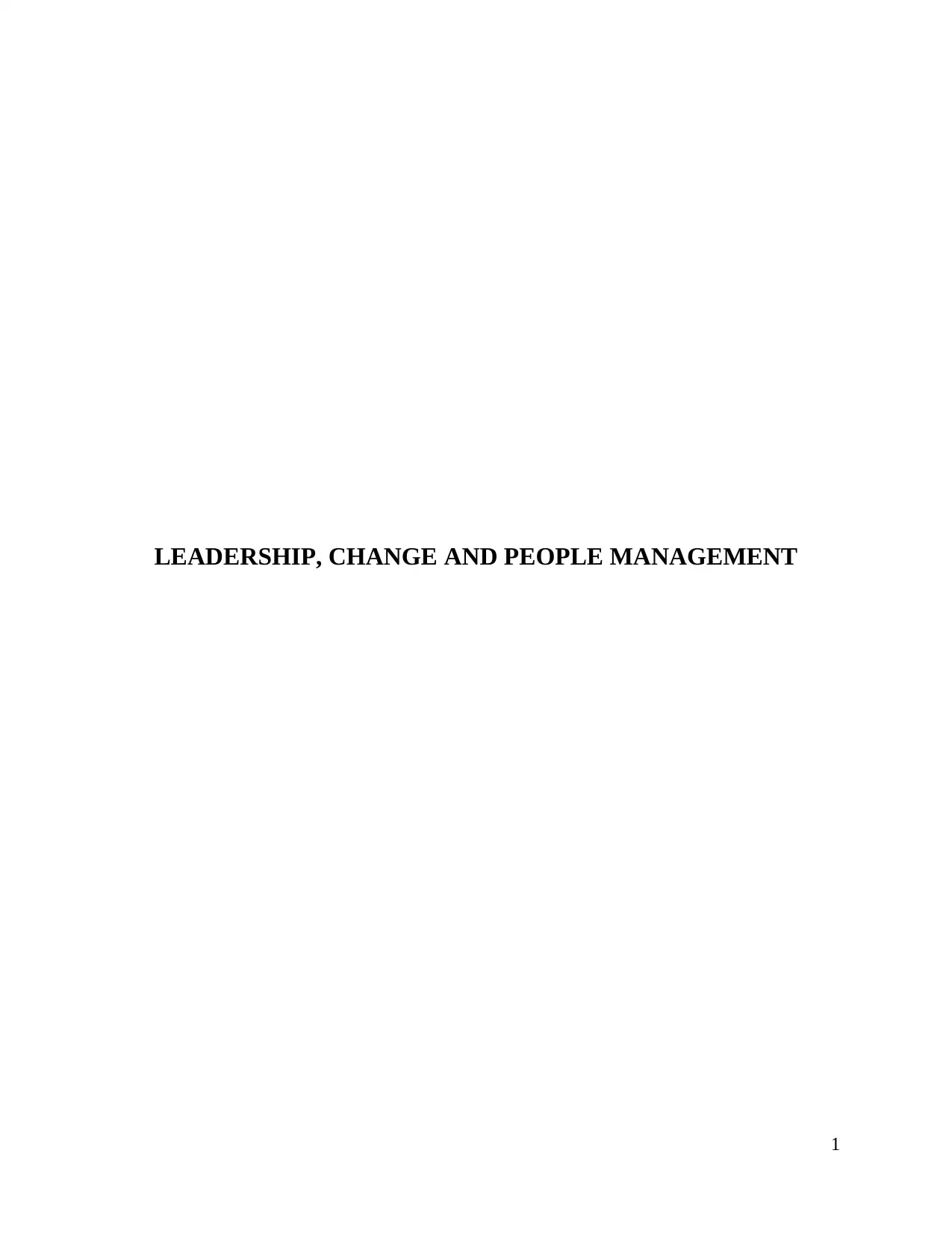
LEADERSHIP, CHANGE AND PEOPLE MANAGEMENT
1
1
Paraphrase This Document
Need a fresh take? Get an instant paraphrase of this document with our AI Paraphraser
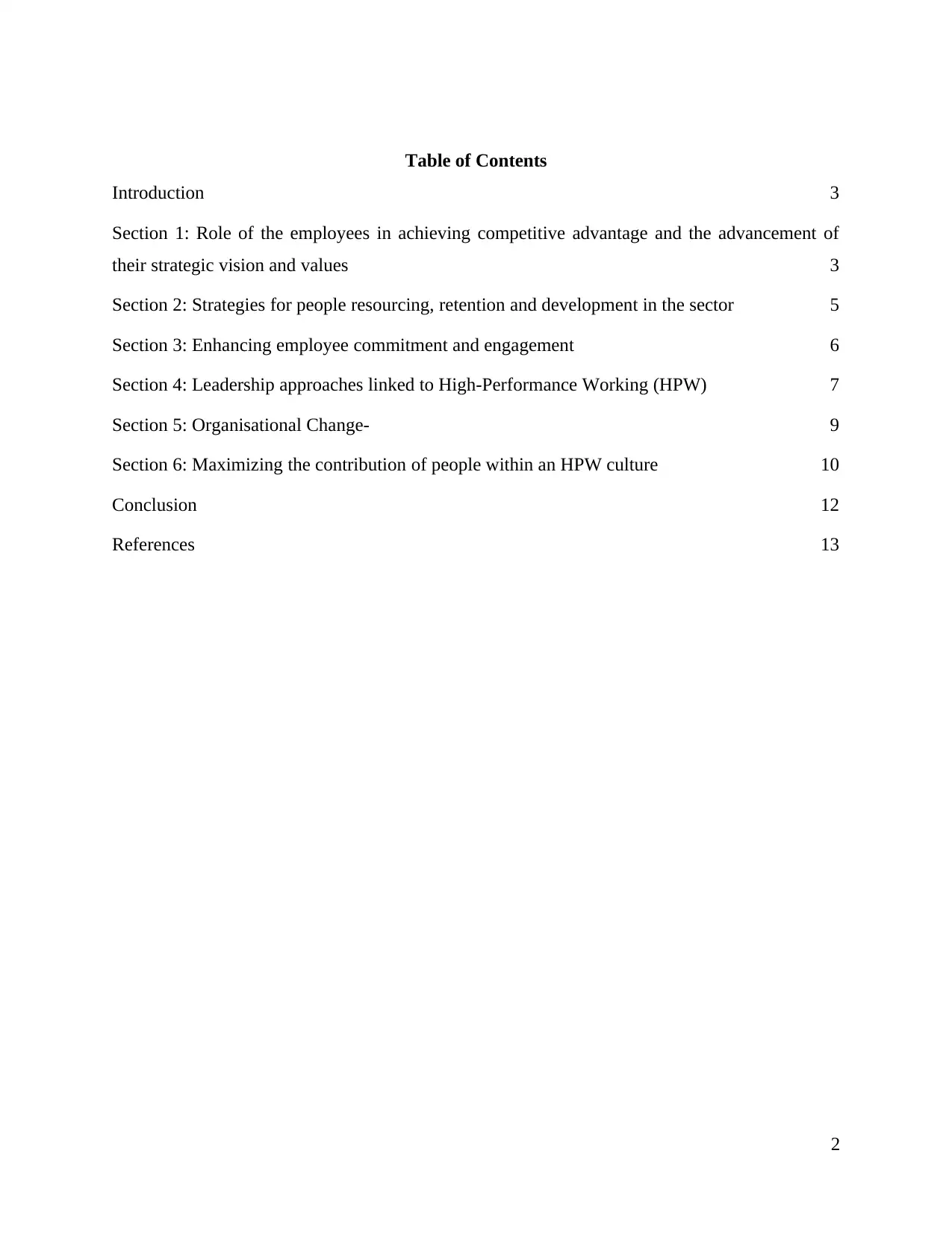
Table of Contents
Introduction 3
Section 1: Role of the employees in achieving competitive advantage and the advancement of
their strategic vision and values 3
Section 2: Strategies for people resourcing, retention and development in the sector 5
Section 3: Enhancing employee commitment and engagement 6
Section 4: Leadership approaches linked to High-Performance Working (HPW) 7
Section 5: Organisational Change- 9
Section 6: Maximizing the contribution of people within an HPW culture 10
Conclusion 12
References 13
2
Introduction 3
Section 1: Role of the employees in achieving competitive advantage and the advancement of
their strategic vision and values 3
Section 2: Strategies for people resourcing, retention and development in the sector 5
Section 3: Enhancing employee commitment and engagement 6
Section 4: Leadership approaches linked to High-Performance Working (HPW) 7
Section 5: Organisational Change- 9
Section 6: Maximizing the contribution of people within an HPW culture 10
Conclusion 12
References 13
2

Introduction
A successful organisation needs an efficient workforce and management. They are the backbone
of any organisations like STC. This company is a perfect example of an efficient level of
management along with maximum productivity through high-performance work and perfect set
of guidelines to achieve success. Identifying individual talent and nurturing them to perform with
effective planning and customized training is the essential thing to be followed by every
organisation. STC did a fine job in this aspect. In the following discussion, the efficiency and the
techniques HTC used to reach its success level is enlightened.
Section 1: Role of the employees in achieving competitive advantage and the
advancement of their strategic vision and values
A company is a structure made by its employees. Employees from different departments work in
a coordinative way to the same objective to achieve for the company. Now business runs through
various difficulties and the employees are bound to deal with these problems. Employees
somehow get in so many problems where they get demotivated towards work. There is the
purpose of the HR team.
HR STRATEGY AND ITS IMPACT- HR departments play a huge role in the success stories
of any business. They maintain the workforce and organise it in a good manner. HR services are
there to meet the needs of employees as well as for the company. To enhance the human capital
of a company HR practice is very important. Hiring new employees to the development of an
organisation, rewarding and recognising hard work of employees properly to make them
motivated towards work, to train employees for their own betterment also make employees
focused about the company objectives (Albrecht et al. 2015).
Competitive advantage is a very subjective term. An organization providing service or
products, at a lower price, maintain the quality and making them affordable than other
companies. This is a competitive advantage. These are strategies used in business where there are
three components. Those are the benefit, the target market and the competitors in the market.
Now benefit means that if a company is offering a product, this has to be in real value and
something that customers do need. Moreover, how their product can benefit the consumer needs
3
A successful organisation needs an efficient workforce and management. They are the backbone
of any organisations like STC. This company is a perfect example of an efficient level of
management along with maximum productivity through high-performance work and perfect set
of guidelines to achieve success. Identifying individual talent and nurturing them to perform with
effective planning and customized training is the essential thing to be followed by every
organisation. STC did a fine job in this aspect. In the following discussion, the efficiency and the
techniques HTC used to reach its success level is enlightened.
Section 1: Role of the employees in achieving competitive advantage and the
advancement of their strategic vision and values
A company is a structure made by its employees. Employees from different departments work in
a coordinative way to the same objective to achieve for the company. Now business runs through
various difficulties and the employees are bound to deal with these problems. Employees
somehow get in so many problems where they get demotivated towards work. There is the
purpose of the HR team.
HR STRATEGY AND ITS IMPACT- HR departments play a huge role in the success stories
of any business. They maintain the workforce and organise it in a good manner. HR services are
there to meet the needs of employees as well as for the company. To enhance the human capital
of a company HR practice is very important. Hiring new employees to the development of an
organisation, rewarding and recognising hard work of employees properly to make them
motivated towards work, to train employees for their own betterment also make employees
focused about the company objectives (Albrecht et al. 2015).
Competitive advantage is a very subjective term. An organization providing service or
products, at a lower price, maintain the quality and making them affordable than other
companies. This is a competitive advantage. These are strategies used in business where there are
three components. Those are the benefit, the target market and the competitors in the market.
Now benefit means that if a company is offering a product, this has to be in real value and
something that customers do need. Moreover, how their product can benefit the consumer needs
3
You're viewing a preview
Unlock full access by subscribing today!
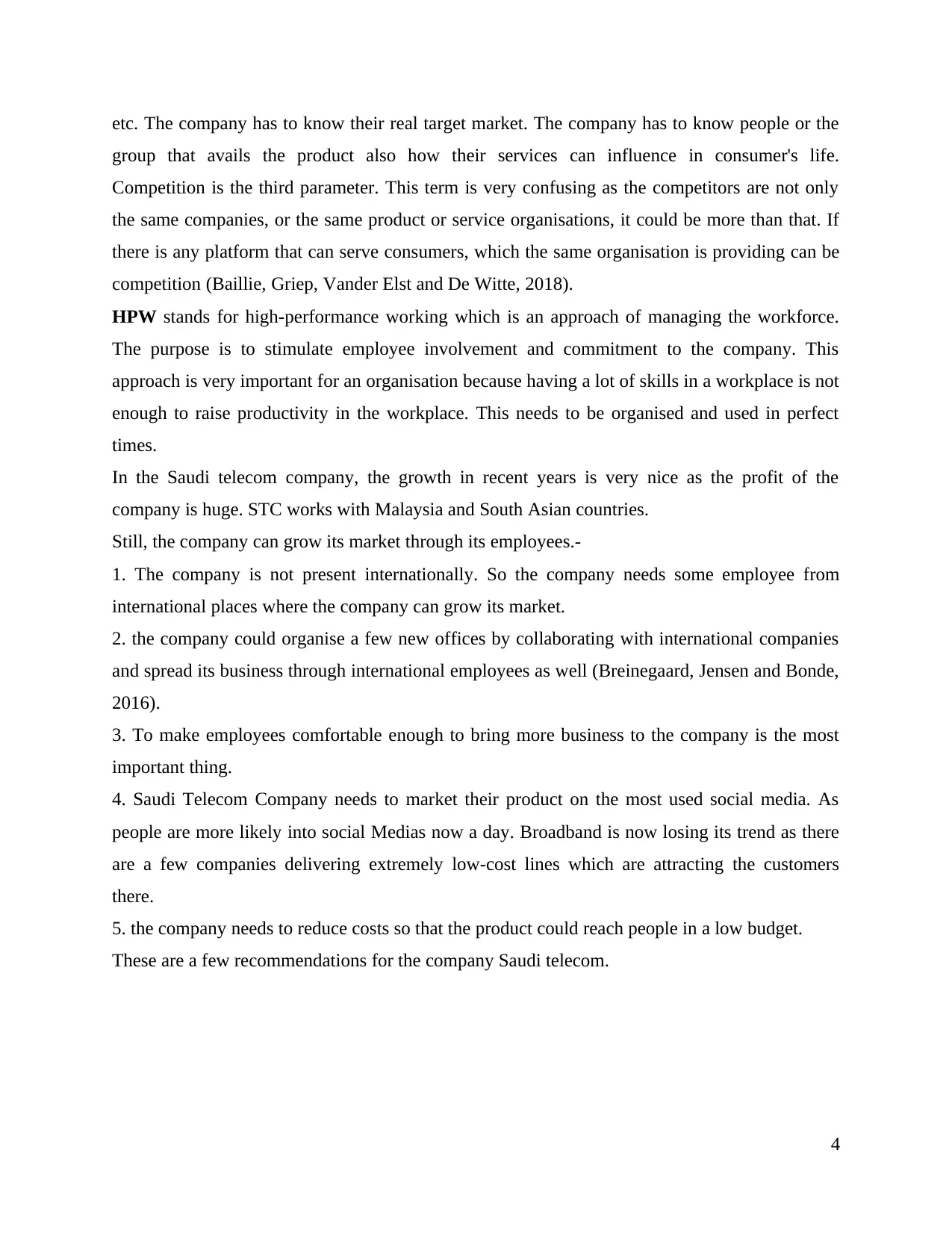
etc. The company has to know their real target market. The company has to know people or the
group that avails the product also how their services can influence in consumer's life.
Competition is the third parameter. This term is very confusing as the competitors are not only
the same companies, or the same product or service organisations, it could be more than that. If
there is any platform that can serve consumers, which the same organisation is providing can be
competition (Baillie, Griep, Vander Elst and De Witte, 2018).
HPW stands for high-performance working which is an approach of managing the workforce.
The purpose is to stimulate employee involvement and commitment to the company. This
approach is very important for an organisation because having a lot of skills in a workplace is not
enough to raise productivity in the workplace. This needs to be organised and used in perfect
times.
In the Saudi telecom company, the growth in recent years is very nice as the profit of the
company is huge. STC works with Malaysia and South Asian countries.
Still, the company can grow its market through its employees.-
1. The company is not present internationally. So the company needs some employee from
international places where the company can grow its market.
2. the company could organise a few new offices by collaborating with international companies
and spread its business through international employees as well (Breinegaard, Jensen and Bonde,
2016).
3. To make employees comfortable enough to bring more business to the company is the most
important thing.
4. Saudi Telecom Company needs to market their product on the most used social media. As
people are more likely into social Medias now a day. Broadband is now losing its trend as there
are a few companies delivering extremely low-cost lines which are attracting the customers
there.
5. the company needs to reduce costs so that the product could reach people in a low budget.
These are a few recommendations for the company Saudi telecom.
4
group that avails the product also how their services can influence in consumer's life.
Competition is the third parameter. This term is very confusing as the competitors are not only
the same companies, or the same product or service organisations, it could be more than that. If
there is any platform that can serve consumers, which the same organisation is providing can be
competition (Baillie, Griep, Vander Elst and De Witte, 2018).
HPW stands for high-performance working which is an approach of managing the workforce.
The purpose is to stimulate employee involvement and commitment to the company. This
approach is very important for an organisation because having a lot of skills in a workplace is not
enough to raise productivity in the workplace. This needs to be organised and used in perfect
times.
In the Saudi telecom company, the growth in recent years is very nice as the profit of the
company is huge. STC works with Malaysia and South Asian countries.
Still, the company can grow its market through its employees.-
1. The company is not present internationally. So the company needs some employee from
international places where the company can grow its market.
2. the company could organise a few new offices by collaborating with international companies
and spread its business through international employees as well (Breinegaard, Jensen and Bonde,
2016).
3. To make employees comfortable enough to bring more business to the company is the most
important thing.
4. Saudi Telecom Company needs to market their product on the most used social media. As
people are more likely into social Medias now a day. Broadband is now losing its trend as there
are a few companies delivering extremely low-cost lines which are attracting the customers
there.
5. the company needs to reduce costs so that the product could reach people in a low budget.
These are a few recommendations for the company Saudi telecom.
4
Paraphrase This Document
Need a fresh take? Get an instant paraphrase of this document with our AI Paraphraser

Section 2: Strategies for people resourcing, retention and development in the
sector
People resourcing- in a company, there are different people who are valuable to the company.
Now to solve a particular business problem, the company needs specific people in the company.
The process through which HR recruiter recruits employee in the company, where they know the
exact needs of the company, and finds employees who are going perfect with the job role. For
this Hr takes a few strategies so that the company can obtain the right employees with proper
qualities, skills and knowledge important for the company and potential to be okay in any
situation. This is called people sourcing strategy. The Telstra on the other hand resources on the
outsourcing of the people for working
People sourcing strategy- the aim for this is to gain competitive advantage through employees
in a right number in the company, having right skills, who will behave in a positive manner in
every situation which will maximize their contribution in the company so that the objective of
the business can be fulfilled. There are a few strategies for integrating the business. The
resourcing is based on understanding the direction of the business and the proper need of the
company (Carter and Phillips, 2015).
To resource people, the HR needs to know
1. The skills required for the company and behaviours required to support the achievement of the
business strategy.
2. The exact number of people the company needs to fulfil its goals.
3. What employees want to be motivated in a company
4. Relocate the employees in the organisation to break the monotonous work also make
employees realise what skills are best in them.
These are a few strategies that HR takes to reach the maximum efficiency in the company for the
Telstra are well aware of the better understanding of the vacancy and the skills of the employees
which helps them in filling the gap efficiently.
People retention- retention of an employee means that the factor that makes the employee
sticks to the company no matter what. Every organisation prepares a newly joined employee into
a proper corporate employee and then makes him introduce to rest of the corporate world. That is
why the retention of an employee is a loss for the company as it already invested time and money
on the employee. The strategies companies take to make an employee stay in a company for a
5
sector
People resourcing- in a company, there are different people who are valuable to the company.
Now to solve a particular business problem, the company needs specific people in the company.
The process through which HR recruiter recruits employee in the company, where they know the
exact needs of the company, and finds employees who are going perfect with the job role. For
this Hr takes a few strategies so that the company can obtain the right employees with proper
qualities, skills and knowledge important for the company and potential to be okay in any
situation. This is called people sourcing strategy. The Telstra on the other hand resources on the
outsourcing of the people for working
People sourcing strategy- the aim for this is to gain competitive advantage through employees
in a right number in the company, having right skills, who will behave in a positive manner in
every situation which will maximize their contribution in the company so that the objective of
the business can be fulfilled. There are a few strategies for integrating the business. The
resourcing is based on understanding the direction of the business and the proper need of the
company (Carter and Phillips, 2015).
To resource people, the HR needs to know
1. The skills required for the company and behaviours required to support the achievement of the
business strategy.
2. The exact number of people the company needs to fulfil its goals.
3. What employees want to be motivated in a company
4. Relocate the employees in the organisation to break the monotonous work also make
employees realise what skills are best in them.
These are a few strategies that HR takes to reach the maximum efficiency in the company for the
Telstra are well aware of the better understanding of the vacancy and the skills of the employees
which helps them in filling the gap efficiently.
People retention- retention of an employee means that the factor that makes the employee
sticks to the company no matter what. Every organisation prepares a newly joined employee into
a proper corporate employee and then makes him introduce to rest of the corporate world. That is
why the retention of an employee is a loss for the company as it already invested time and money
on the employee. The strategies companies take to make an employee stay in a company for a
5

long time is called the employee retention strategy (Ceulemans, Lozano and Alonso-Almeida,
2015).
Employee retention strategies-
1. Employees need to understand some phases, related to where the employees are getting
responsibility for the company. The objective of the company is targeted towards interprocessing
the work. In order to make sure the organisation achieve maximum growth, there objective needs
to be clear by supporting the employees.
2. Mentorship is the second way where new employees get mentored under an expert to know
the work in the company
3. Employee compensation is very important in this competitive world. Employees need to be
recognised for their work in two ways, by discussing the hard work to motivate more people and
secondly through incentives to motivate them for the future.
Also, there are a few more ways like work-life balance which says that the employees should get
offs for vacation or a few benefits like late arrival if they have a late night, compensation with
the extra day off. These are a few strategies that a company takes to retain employees for a
longer time (Cheema, Akram and Javed, 2015).
The Saudi telecom company has to be more effective for the employees. The telecom companies
are going a little down now a day as it has a huge competitor. There are hundreds of operators all
over the place. Internet services are more likely to be free for the company. The company needs
to attract people to this with cheap offers (Feistel and Ebeling, 2016).
Some way or the other the Telstra have always followed simple strategies that well apprehended
by the employees.
Section 3: Enhancing employee commitment and engagement
The employee commitment and engagement is a workplace approach for the employees to make
them attached to the company goals and values and work as hard as possible to give the best each
day.
Enhance employee commitment- now for the betterment of the company needs to take care of a
few things so that the employees be loyal or committed to the company. Such as
1. Construct career growth – constructing career growth is a huge thing to make employees
committed to the company. Employees are more interested in the company gives the opportunity
6
2015).
Employee retention strategies-
1. Employees need to understand some phases, related to where the employees are getting
responsibility for the company. The objective of the company is targeted towards interprocessing
the work. In order to make sure the organisation achieve maximum growth, there objective needs
to be clear by supporting the employees.
2. Mentorship is the second way where new employees get mentored under an expert to know
the work in the company
3. Employee compensation is very important in this competitive world. Employees need to be
recognised for their work in two ways, by discussing the hard work to motivate more people and
secondly through incentives to motivate them for the future.
Also, there are a few more ways like work-life balance which says that the employees should get
offs for vacation or a few benefits like late arrival if they have a late night, compensation with
the extra day off. These are a few strategies that a company takes to retain employees for a
longer time (Cheema, Akram and Javed, 2015).
The Saudi telecom company has to be more effective for the employees. The telecom companies
are going a little down now a day as it has a huge competitor. There are hundreds of operators all
over the place. Internet services are more likely to be free for the company. The company needs
to attract people to this with cheap offers (Feistel and Ebeling, 2016).
Some way or the other the Telstra have always followed simple strategies that well apprehended
by the employees.
Section 3: Enhancing employee commitment and engagement
The employee commitment and engagement is a workplace approach for the employees to make
them attached to the company goals and values and work as hard as possible to give the best each
day.
Enhance employee commitment- now for the betterment of the company needs to take care of a
few things so that the employees be loyal or committed to the company. Such as
1. Construct career growth – constructing career growth is a huge thing to make employees
committed to the company. Employees are more interested in the company gives the opportunity
6
You're viewing a preview
Unlock full access by subscribing today!
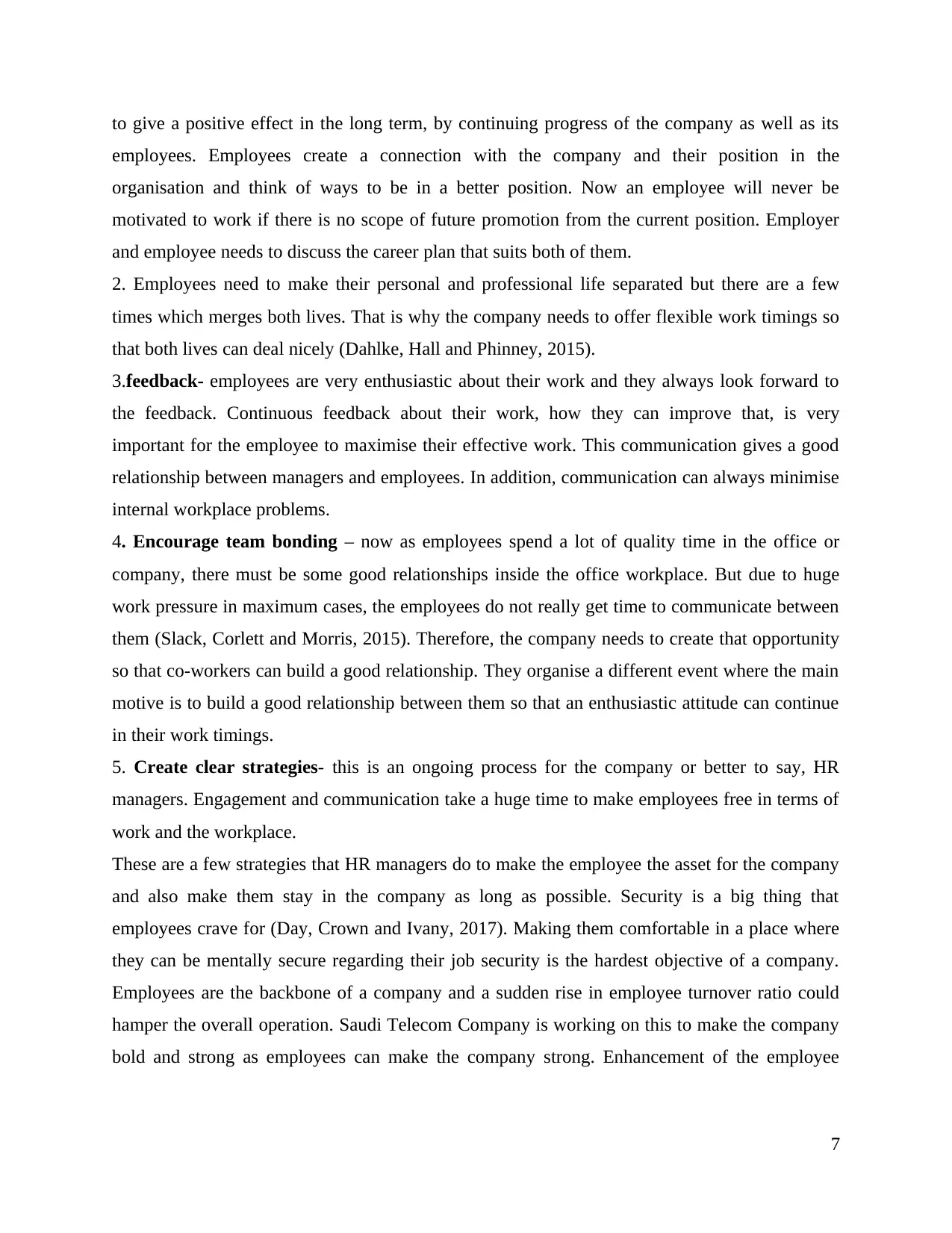
to give a positive effect in the long term, by continuing progress of the company as well as its
employees. Employees create a connection with the company and their position in the
organisation and think of ways to be in a better position. Now an employee will never be
motivated to work if there is no scope of future promotion from the current position. Employer
and employee needs to discuss the career plan that suits both of them.
2. Employees need to make their personal and professional life separated but there are a few
times which merges both lives. That is why the company needs to offer flexible work timings so
that both lives can deal nicely (Dahlke, Hall and Phinney, 2015).
3.feedback- employees are very enthusiastic about their work and they always look forward to
the feedback. Continuous feedback about their work, how they can improve that, is very
important for the employee to maximise their effective work. This communication gives a good
relationship between managers and employees. In addition, communication can always minimise
internal workplace problems.
4. Encourage team bonding – now as employees spend a lot of quality time in the office or
company, there must be some good relationships inside the office workplace. But due to huge
work pressure in maximum cases, the employees do not really get time to communicate between
them (Slack, Corlett and Morris, 2015). Therefore, the company needs to create that opportunity
so that co-workers can build a good relationship. They organise a different event where the main
motive is to build a good relationship between them so that an enthusiastic attitude can continue
in their work timings.
5. Create clear strategies- this is an ongoing process for the company or better to say, HR
managers. Engagement and communication take a huge time to make employees free in terms of
work and the workplace.
These are a few strategies that HR managers do to make the employee the asset for the company
and also make them stay in the company as long as possible. Security is a big thing that
employees crave for (Day, Crown and Ivany, 2017). Making them comfortable in a place where
they can be mentally secure regarding their job security is the hardest objective of a company.
Employees are the backbone of a company and a sudden rise in employee turnover ratio could
hamper the overall operation. Saudi Telecom Company is working on this to make the company
bold and strong as employees can make the company strong. Enhancement of the employee
7
employees. Employees create a connection with the company and their position in the
organisation and think of ways to be in a better position. Now an employee will never be
motivated to work if there is no scope of future promotion from the current position. Employer
and employee needs to discuss the career plan that suits both of them.
2. Employees need to make their personal and professional life separated but there are a few
times which merges both lives. That is why the company needs to offer flexible work timings so
that both lives can deal nicely (Dahlke, Hall and Phinney, 2015).
3.feedback- employees are very enthusiastic about their work and they always look forward to
the feedback. Continuous feedback about their work, how they can improve that, is very
important for the employee to maximise their effective work. This communication gives a good
relationship between managers and employees. In addition, communication can always minimise
internal workplace problems.
4. Encourage team bonding – now as employees spend a lot of quality time in the office or
company, there must be some good relationships inside the office workplace. But due to huge
work pressure in maximum cases, the employees do not really get time to communicate between
them (Slack, Corlett and Morris, 2015). Therefore, the company needs to create that opportunity
so that co-workers can build a good relationship. They organise a different event where the main
motive is to build a good relationship between them so that an enthusiastic attitude can continue
in their work timings.
5. Create clear strategies- this is an ongoing process for the company or better to say, HR
managers. Engagement and communication take a huge time to make employees free in terms of
work and the workplace.
These are a few strategies that HR managers do to make the employee the asset for the company
and also make them stay in the company as long as possible. Security is a big thing that
employees crave for (Day, Crown and Ivany, 2017). Making them comfortable in a place where
they can be mentally secure regarding their job security is the hardest objective of a company.
Employees are the backbone of a company and a sudden rise in employee turnover ratio could
hamper the overall operation. Saudi Telecom Company is working on this to make the company
bold and strong as employees can make the company strong. Enhancement of the employee
7
Paraphrase This Document
Need a fresh take? Get an instant paraphrase of this document with our AI Paraphraser
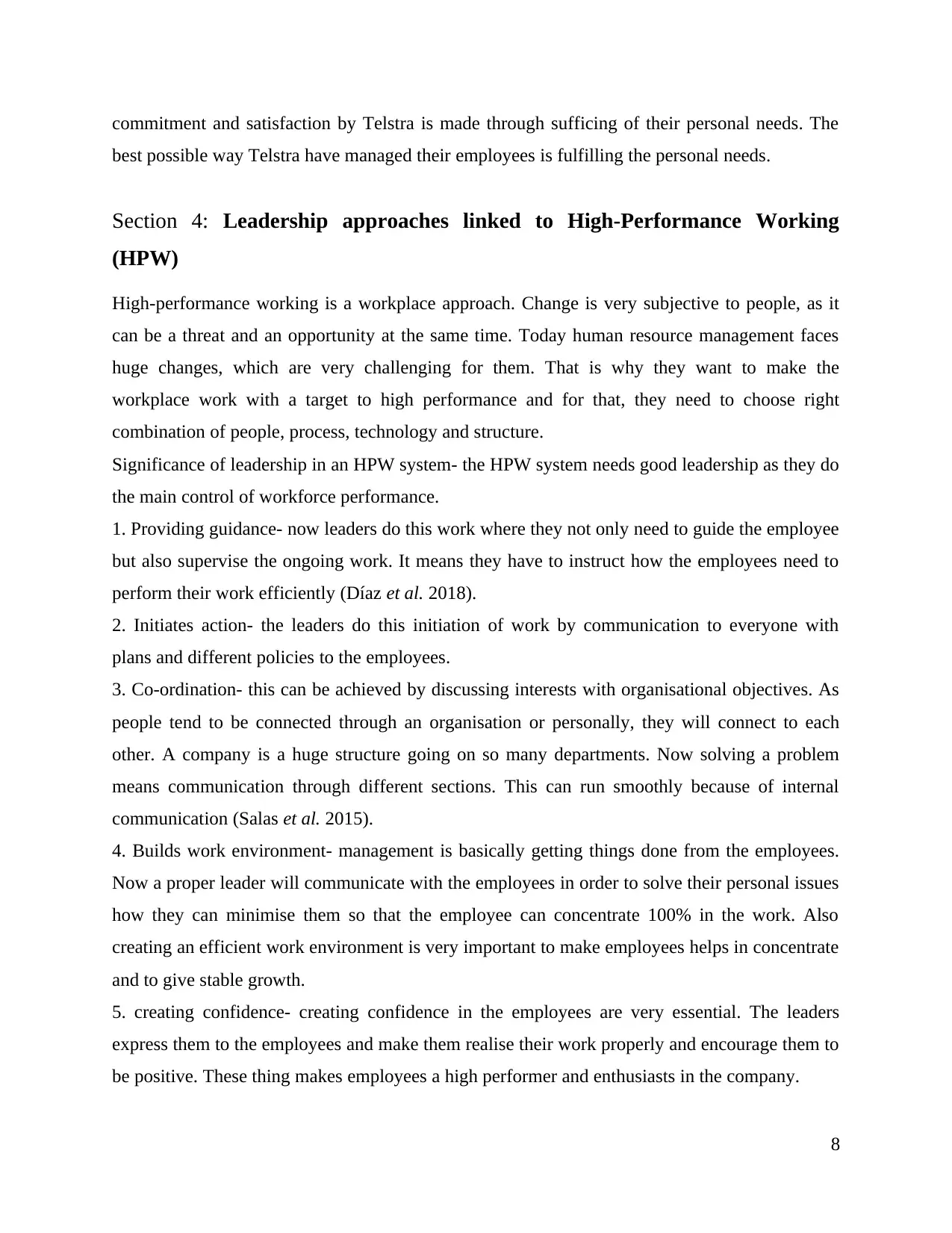
commitment and satisfaction by Telstra is made through sufficing of their personal needs. The
best possible way Telstra have managed their employees is fulfilling the personal needs.
Section 4: Leadership approaches linked to High-Performance Working
(HPW)
High-performance working is a workplace approach. Change is very subjective to people, as it
can be a threat and an opportunity at the same time. Today human resource management faces
huge changes, which are very challenging for them. That is why they want to make the
workplace work with a target to high performance and for that, they need to choose right
combination of people, process, technology and structure.
Significance of leadership in an HPW system- the HPW system needs good leadership as they do
the main control of workforce performance.
1. Providing guidance- now leaders do this work where they not only need to guide the employee
but also supervise the ongoing work. It means they have to instruct how the employees need to
perform their work efficiently (Díaz et al. 2018).
2. Initiates action- the leaders do this initiation of work by communication to everyone with
plans and different policies to the employees.
3. Co-ordination- this can be achieved by discussing interests with organisational objectives. As
people tend to be connected through an organisation or personally, they will connect to each
other. A company is a huge structure going on so many departments. Now solving a problem
means communication through different sections. This can run smoothly because of internal
communication (Salas et al. 2015).
4. Builds work environment- management is basically getting things done from the employees.
Now a proper leader will communicate with the employees in order to solve their personal issues
how they can minimise them so that the employee can concentrate 100% in the work. Also
creating an efficient work environment is very important to make employees helps in concentrate
and to give stable growth.
5. creating confidence- creating confidence in the employees are very essential. The leaders
express them to the employees and make them realise their work properly and encourage them to
be positive. These thing makes employees a high performer and enthusiasts in the company.
8
best possible way Telstra have managed their employees is fulfilling the personal needs.
Section 4: Leadership approaches linked to High-Performance Working
(HPW)
High-performance working is a workplace approach. Change is very subjective to people, as it
can be a threat and an opportunity at the same time. Today human resource management faces
huge changes, which are very challenging for them. That is why they want to make the
workplace work with a target to high performance and for that, they need to choose right
combination of people, process, technology and structure.
Significance of leadership in an HPW system- the HPW system needs good leadership as they do
the main control of workforce performance.
1. Providing guidance- now leaders do this work where they not only need to guide the employee
but also supervise the ongoing work. It means they have to instruct how the employees need to
perform their work efficiently (Díaz et al. 2018).
2. Initiates action- the leaders do this initiation of work by communication to everyone with
plans and different policies to the employees.
3. Co-ordination- this can be achieved by discussing interests with organisational objectives. As
people tend to be connected through an organisation or personally, they will connect to each
other. A company is a huge structure going on so many departments. Now solving a problem
means communication through different sections. This can run smoothly because of internal
communication (Salas et al. 2015).
4. Builds work environment- management is basically getting things done from the employees.
Now a proper leader will communicate with the employees in order to solve their personal issues
how they can minimise them so that the employee can concentrate 100% in the work. Also
creating an efficient work environment is very important to make employees helps in concentrate
and to give stable growth.
5. creating confidence- creating confidence in the employees are very essential. The leaders
express them to the employees and make them realise their work properly and encourage them to
be positive. These thing makes employees a high performer and enthusiasts in the company.
8
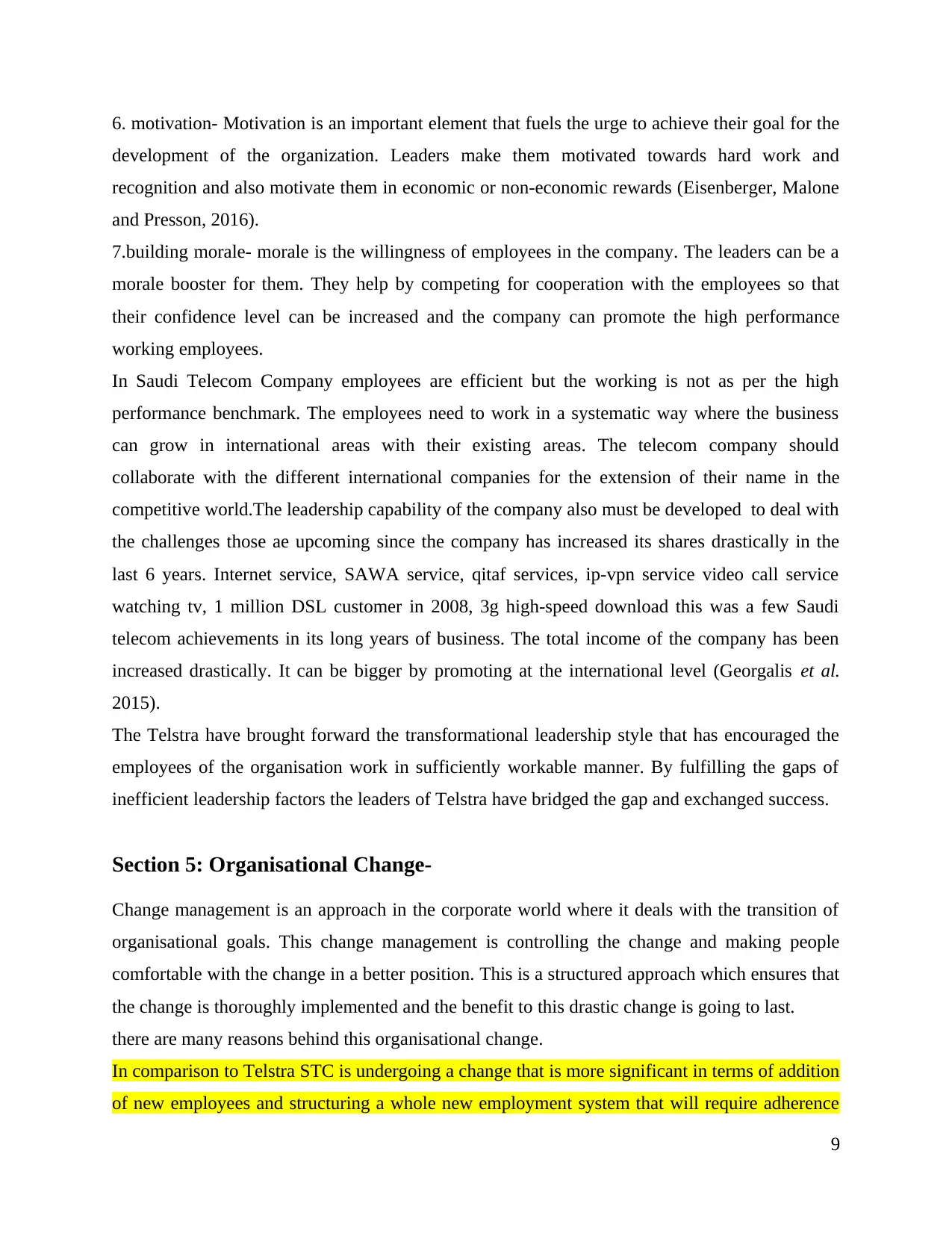
6. motivation- Motivation is an important element that fuels the urge to achieve their goal for the
development of the organization. Leaders make them motivated towards hard work and
recognition and also motivate them in economic or non-economic rewards (Eisenberger, Malone
and Presson, 2016).
7.building morale- morale is the willingness of employees in the company. The leaders can be a
morale booster for them. They help by competing for cooperation with the employees so that
their confidence level can be increased and the company can promote the high performance
working employees.
In Saudi Telecom Company employees are efficient but the working is not as per the high
performance benchmark. The employees need to work in a systematic way where the business
can grow in international areas with their existing areas. The telecom company should
collaborate with the different international companies for the extension of their name in the
competitive world.The leadership capability of the company also must be developed to deal with
the challenges those ae upcoming since the company has increased its shares drastically in the
last 6 years. Internet service, SAWA service, qitaf services, ip-vpn service video call service
watching tv, 1 million DSL customer in 2008, 3g high-speed download this was a few Saudi
telecom achievements in its long years of business. The total income of the company has been
increased drastically. It can be bigger by promoting at the international level (Georgalis et al.
2015).
The Telstra have brought forward the transformational leadership style that has encouraged the
employees of the organisation work in sufficiently workable manner. By fulfilling the gaps of
inefficient leadership factors the leaders of Telstra have bridged the gap and exchanged success.
Section 5: Organisational Change-
Change management is an approach in the corporate world where it deals with the transition of
organisational goals. This change management is controlling the change and making people
comfortable with the change in a better position. This is a structured approach which ensures that
the change is thoroughly implemented and the benefit to this drastic change is going to last.
there are many reasons behind this organisational change.
In comparison to Telstra STC is undergoing a change that is more significant in terms of addition
of new employees and structuring a whole new employment system that will require adherence
9
development of the organization. Leaders make them motivated towards hard work and
recognition and also motivate them in economic or non-economic rewards (Eisenberger, Malone
and Presson, 2016).
7.building morale- morale is the willingness of employees in the company. The leaders can be a
morale booster for them. They help by competing for cooperation with the employees so that
their confidence level can be increased and the company can promote the high performance
working employees.
In Saudi Telecom Company employees are efficient but the working is not as per the high
performance benchmark. The employees need to work in a systematic way where the business
can grow in international areas with their existing areas. The telecom company should
collaborate with the different international companies for the extension of their name in the
competitive world.The leadership capability of the company also must be developed to deal with
the challenges those ae upcoming since the company has increased its shares drastically in the
last 6 years. Internet service, SAWA service, qitaf services, ip-vpn service video call service
watching tv, 1 million DSL customer in 2008, 3g high-speed download this was a few Saudi
telecom achievements in its long years of business. The total income of the company has been
increased drastically. It can be bigger by promoting at the international level (Georgalis et al.
2015).
The Telstra have brought forward the transformational leadership style that has encouraged the
employees of the organisation work in sufficiently workable manner. By fulfilling the gaps of
inefficient leadership factors the leaders of Telstra have bridged the gap and exchanged success.
Section 5: Organisational Change-
Change management is an approach in the corporate world where it deals with the transition of
organisational goals. This change management is controlling the change and making people
comfortable with the change in a better position. This is a structured approach which ensures that
the change is thoroughly implemented and the benefit to this drastic change is going to last.
there are many reasons behind this organisational change.
In comparison to Telstra STC is undergoing a change that is more significant in terms of addition
of new employees and structuring a whole new employment system that will require adherence
9
You're viewing a preview
Unlock full access by subscribing today!

to some basic change management models for a smooth transition (Pollack and Pollack, 2015).
Lewin’s Change management model in this case will be relevant as it implies that during a
certain drastic change in an organisation, the process must be broken into three section. Freeze,
change and unfreeze. this implies that all relevant sections of the company that are going to
increase their employee strength need to be stopped while the new employees are added . after
they are successfully registered to their respective positions, the department may come back to
its original functionality.
the second change that the company will undergo will be the addition of new workplace. this
change will be required to follow the Kotter's theory of change. As this may lead to a sense of
confusion in the workforce thE first objective will be to create a sense of urgency. this will form
coalitions which will help in the transitions there will be a team effort (Gneezy and Imas, 2017).
a vision of the new direction will be formed an everyone will be led on board. this will accelerate
the process of achieving normalcy which will in turn make the transition set in stone.
In accordance to contingency theory of leadership, the organisational change that the company
will be going through will have emphasis on different variables in specific setting that will
specify the type and style of leadership that the company will need during this process. As this
theory is based n the principle that no one particular style of leadership is suitable to every
situation that may arise improvisation capabilities will be essential. STC will be undergoing
major situational anomalies during this particular period of change ad it will be important that
the leader is able to understand every situation and improvise a solution accordingly.(Hanaysha,
2016).
the situational theory of leadership will also be applicable during this period as there it implies
that leadership approaches depend on the type of situation that needs the attention of situation.
the theory discusses that a leader should apply leadership by approaching cert pertinent to an
event that he leader is required to oversee. STC is also going through well with their positive
attitude managers but it needs to develop techniques to grow its employee control and be
professionally best in the telecom industry.
Building up satisfactory change management policies have made Telstra quite effective in
dealing with external business environment threat. The very possible management of the
organisation is done through decentralisation of power among the managers and the leaders of
the organisation.
10
Lewin’s Change management model in this case will be relevant as it implies that during a
certain drastic change in an organisation, the process must be broken into three section. Freeze,
change and unfreeze. this implies that all relevant sections of the company that are going to
increase their employee strength need to be stopped while the new employees are added . after
they are successfully registered to their respective positions, the department may come back to
its original functionality.
the second change that the company will undergo will be the addition of new workplace. this
change will be required to follow the Kotter's theory of change. As this may lead to a sense of
confusion in the workforce thE first objective will be to create a sense of urgency. this will form
coalitions which will help in the transitions there will be a team effort (Gneezy and Imas, 2017).
a vision of the new direction will be formed an everyone will be led on board. this will accelerate
the process of achieving normalcy which will in turn make the transition set in stone.
In accordance to contingency theory of leadership, the organisational change that the company
will be going through will have emphasis on different variables in specific setting that will
specify the type and style of leadership that the company will need during this process. As this
theory is based n the principle that no one particular style of leadership is suitable to every
situation that may arise improvisation capabilities will be essential. STC will be undergoing
major situational anomalies during this particular period of change ad it will be important that
the leader is able to understand every situation and improvise a solution accordingly.(Hanaysha,
2016).
the situational theory of leadership will also be applicable during this period as there it implies
that leadership approaches depend on the type of situation that needs the attention of situation.
the theory discusses that a leader should apply leadership by approaching cert pertinent to an
event that he leader is required to oversee. STC is also going through well with their positive
attitude managers but it needs to develop techniques to grow its employee control and be
professionally best in the telecom industry.
Building up satisfactory change management policies have made Telstra quite effective in
dealing with external business environment threat. The very possible management of the
organisation is done through decentralisation of power among the managers and the leaders of
the organisation.
10
Paraphrase This Document
Need a fresh take? Get an instant paraphrase of this document with our AI Paraphraser

Section 6: Maximizing the contribution of people within an HPW culture
HPW or high-performance work is referred to like the practices an organization does to
maximize the productivity level and optimizing the outcomes. This is done by efficiently hiring
people by judging their potential, competencies. Also, this is done by training them and nurturing
their capabilities and retaining them successfully.
The STC Company has to identify how to define the behaviour, attitude and the skills which
workers need to have to perform in an organization to achieve the desired goal. How they are
going to be qualified for a specific job and what measure should be used for selecting them
(Hottenrott, Rexhäuser and Veugelers, 2016). Some people think that formal education is the
important measure. Other thinks that the most important measure is on the job training. Also,
some believe that individuals' personal characteristics are the main driving force. However, all of
this measure is important. But as a single none of these are quite enough to fulfill the
requirement s for the job. The more efficient way is to link the individual's performance with
each other to achieve the set of goals defined by the organization. To do these the STS is
evaluating the competencies and capabilities of the individuals. These are the judgment,
knowledge, skills and the attributes which are required for achieving the goal. This is the main
success criteria of the STC Company as they have defined a set of competency and capability. It
shows the employee of STC which and what type of behaviour and performance is valued by the
company (Miletzki and Broten, 2017). It also fulfils the objective of the company to meet its
goal. In this way, not only the employees or the group of employees work efficiently but also
there are several other things that add to the benefit of the organization.
Defining the competencies and the capabilities in an organization helps to improve the HPW by
the following way.
Make the change of management or leadership process more accurately
● Making sure that the people are showing the enquired expertise for the job
● Recruiting the staffs properly judging their potentials accurately.
● Design and provide customized training for the individual based on their evaluation
11
HPW or high-performance work is referred to like the practices an organization does to
maximize the productivity level and optimizing the outcomes. This is done by efficiently hiring
people by judging their potential, competencies. Also, this is done by training them and nurturing
their capabilities and retaining them successfully.
The STC Company has to identify how to define the behaviour, attitude and the skills which
workers need to have to perform in an organization to achieve the desired goal. How they are
going to be qualified for a specific job and what measure should be used for selecting them
(Hottenrott, Rexhäuser and Veugelers, 2016). Some people think that formal education is the
important measure. Other thinks that the most important measure is on the job training. Also,
some believe that individuals' personal characteristics are the main driving force. However, all of
this measure is important. But as a single none of these are quite enough to fulfill the
requirement s for the job. The more efficient way is to link the individual's performance with
each other to achieve the set of goals defined by the organization. To do these the STS is
evaluating the competencies and capabilities of the individuals. These are the judgment,
knowledge, skills and the attributes which are required for achieving the goal. This is the main
success criteria of the STC Company as they have defined a set of competency and capability. It
shows the employee of STC which and what type of behaviour and performance is valued by the
company (Miletzki and Broten, 2017). It also fulfils the objective of the company to meet its
goal. In this way, not only the employees or the group of employees work efficiently but also
there are several other things that add to the benefit of the organization.
Defining the competencies and the capabilities in an organization helps to improve the HPW by
the following way.
Make the change of management or leadership process more accurately
● Making sure that the people are showing the enquired expertise for the job
● Recruiting the staffs properly judging their potentials accurately.
● Design and provide customized training for the individual based on their evaluation
11
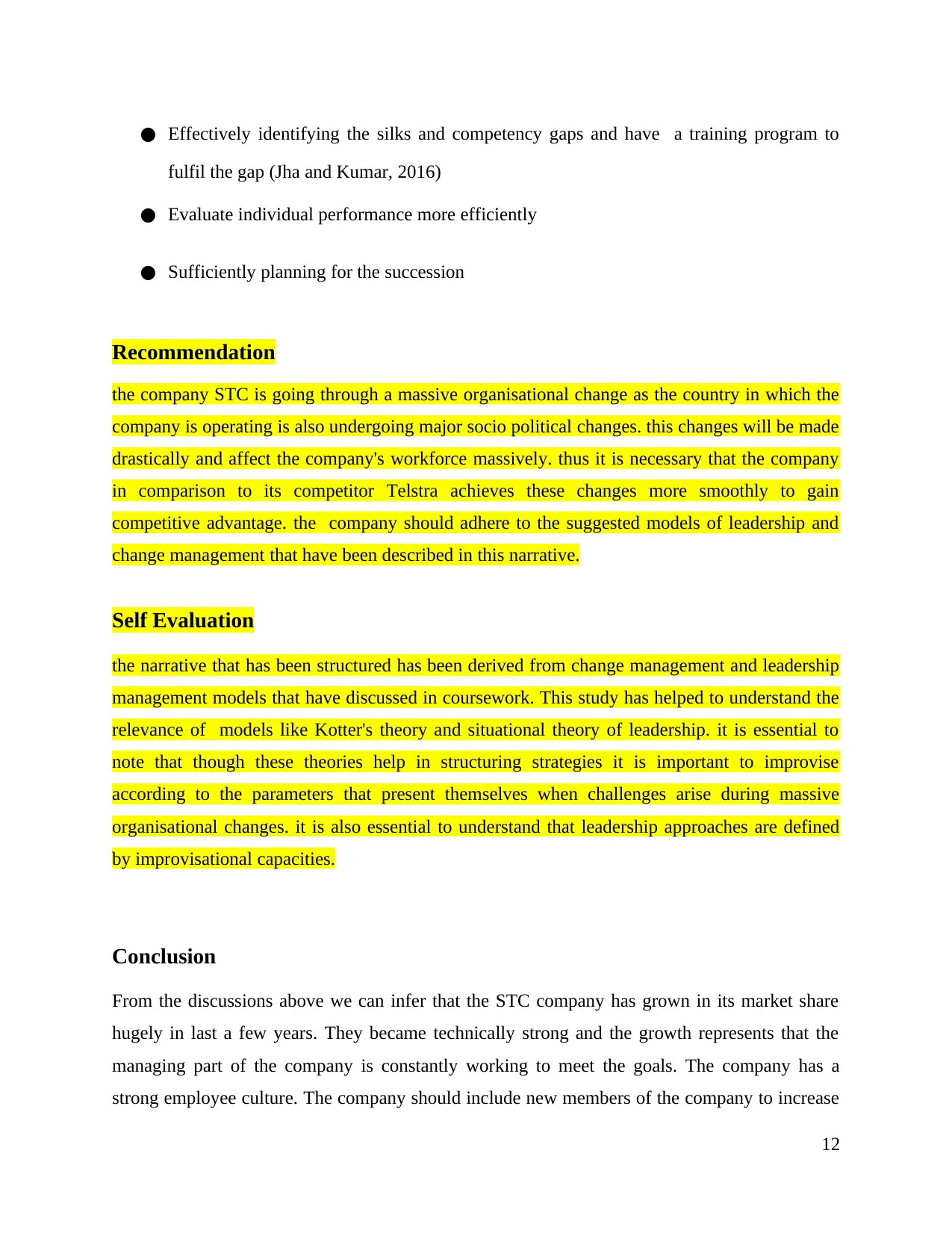
● Effectively identifying the silks and competency gaps and have a training program to
fulfil the gap (Jha and Kumar, 2016)
● Evaluate individual performance more efficiently
● Sufficiently planning for the succession
Recommendation
the company STC is going through a massive organisational change as the country in which the
company is operating is also undergoing major socio political changes. this changes will be made
drastically and affect the company's workforce massively. thus it is necessary that the company
in comparison to its competitor Telstra achieves these changes more smoothly to gain
competitive advantage. the company should adhere to the suggested models of leadership and
change management that have been described in this narrative.
Self Evaluation
the narrative that has been structured has been derived from change management and leadership
management models that have discussed in coursework. This study has helped to understand the
relevance of models like Kotter's theory and situational theory of leadership. it is essential to
note that though these theories help in structuring strategies it is important to improvise
according to the parameters that present themselves when challenges arise during massive
organisational changes. it is also essential to understand that leadership approaches are defined
by improvisational capacities.
Conclusion
From the discussions above we can infer that the STC company has grown in its market share
hugely in last a few years. They became technically strong and the growth represents that the
managing part of the company is constantly working to meet the goals. The company has a
strong employee culture. The company should include new members of the company to increase
12
fulfil the gap (Jha and Kumar, 2016)
● Evaluate individual performance more efficiently
● Sufficiently planning for the succession
Recommendation
the company STC is going through a massive organisational change as the country in which the
company is operating is also undergoing major socio political changes. this changes will be made
drastically and affect the company's workforce massively. thus it is necessary that the company
in comparison to its competitor Telstra achieves these changes more smoothly to gain
competitive advantage. the company should adhere to the suggested models of leadership and
change management that have been described in this narrative.
Self Evaluation
the narrative that has been structured has been derived from change management and leadership
management models that have discussed in coursework. This study has helped to understand the
relevance of models like Kotter's theory and situational theory of leadership. it is essential to
note that though these theories help in structuring strategies it is important to improvise
according to the parameters that present themselves when challenges arise during massive
organisational changes. it is also essential to understand that leadership approaches are defined
by improvisational capacities.
Conclusion
From the discussions above we can infer that the STC company has grown in its market share
hugely in last a few years. They became technically strong and the growth represents that the
managing part of the company is constantly working to meet the goals. The company has a
strong employee culture. The company should include new members of the company to increase
12
You're viewing a preview
Unlock full access by subscribing today!
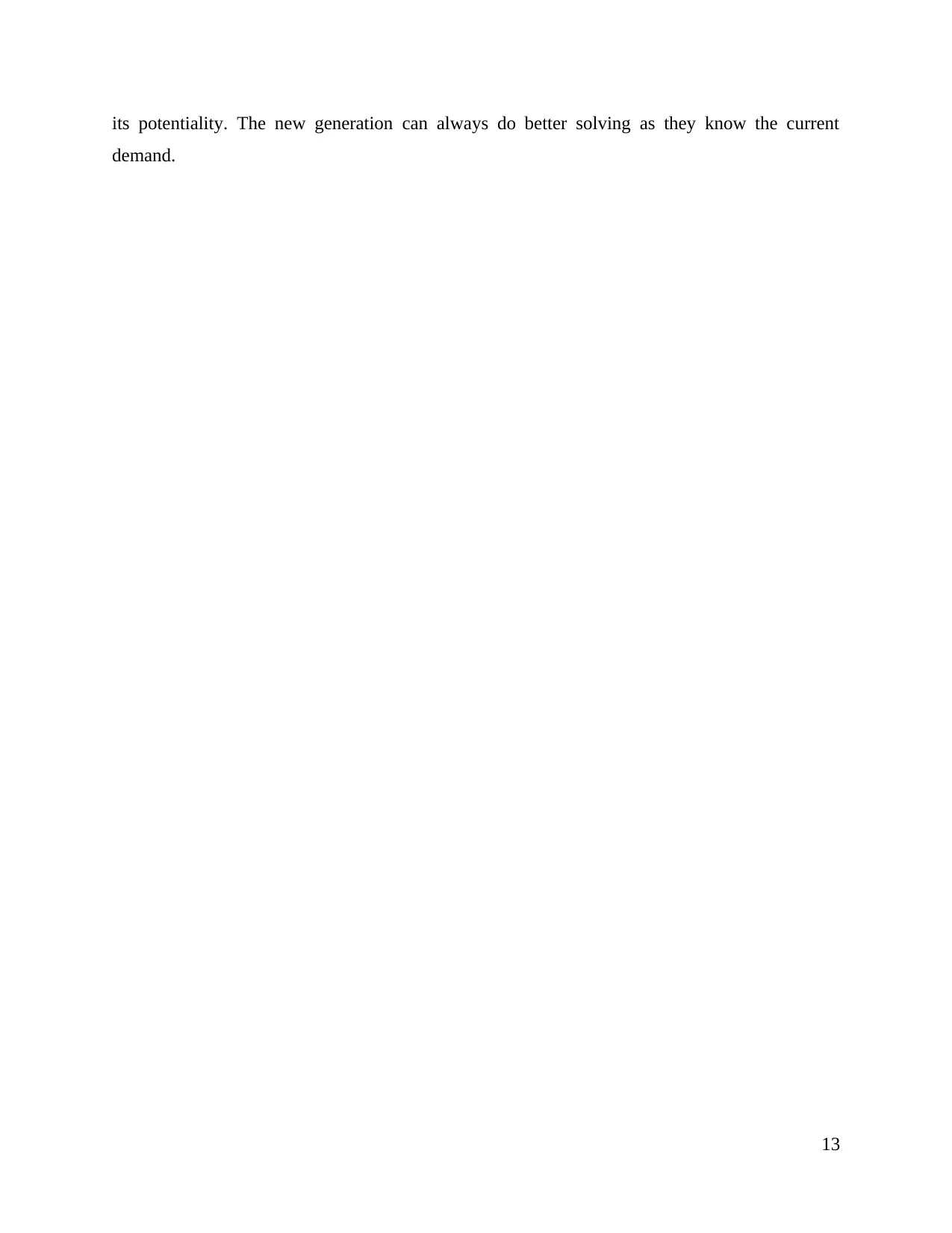
its potentiality. The new generation can always do better solving as they know the current
demand.
13
demand.
13
Paraphrase This Document
Need a fresh take? Get an instant paraphrase of this document with our AI Paraphraser
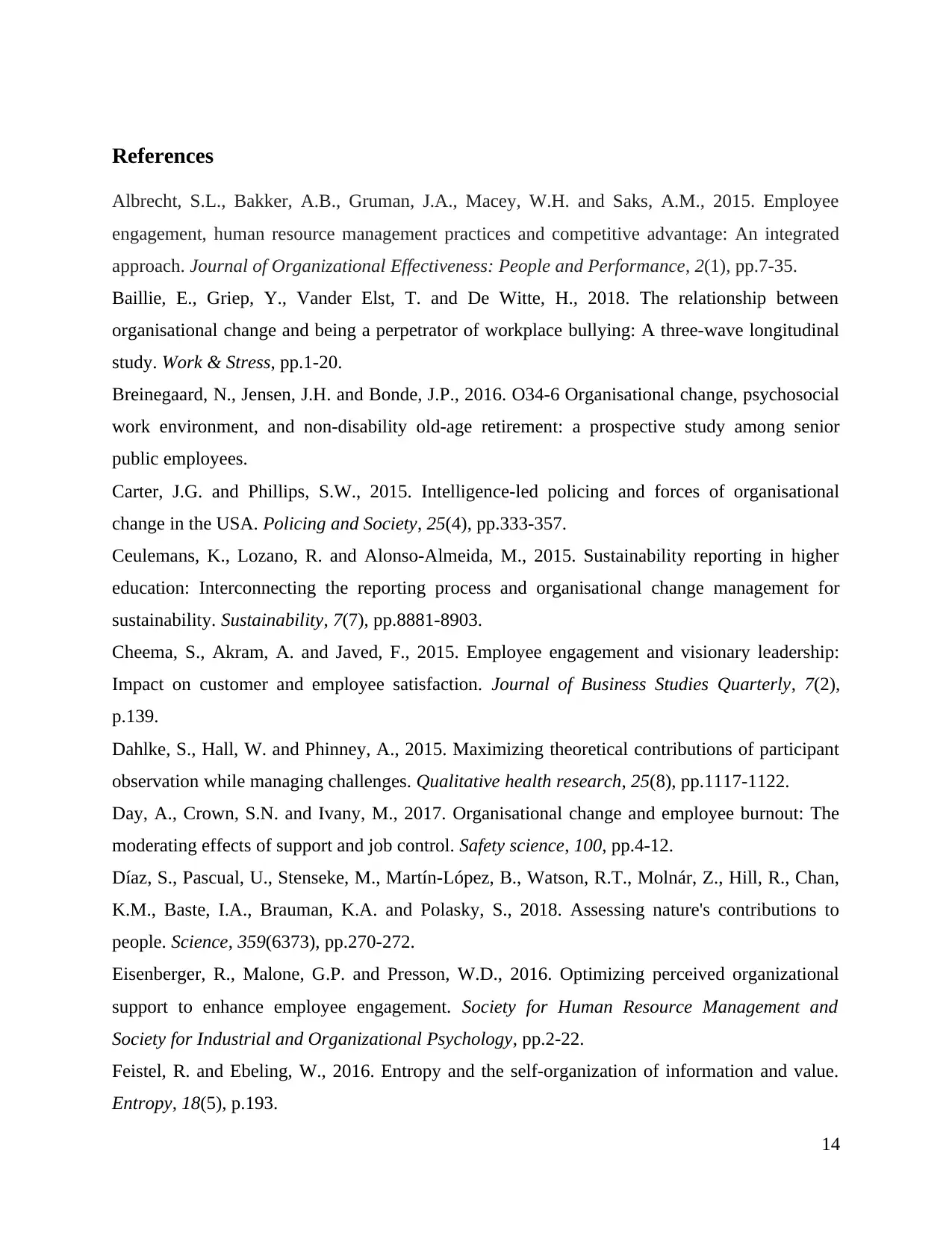
References
Albrecht, S.L., Bakker, A.B., Gruman, J.A., Macey, W.H. and Saks, A.M., 2015. Employee
engagement, human resource management practices and competitive advantage: An integrated
approach. Journal of Organizational Effectiveness: People and Performance, 2(1), pp.7-35.
Baillie, E., Griep, Y., Vander Elst, T. and De Witte, H., 2018. The relationship between
organisational change and being a perpetrator of workplace bullying: A three-wave longitudinal
study. Work & Stress, pp.1-20.
Breinegaard, N., Jensen, J.H. and Bonde, J.P., 2016. O34-6 Organisational change, psychosocial
work environment, and non-disability old-age retirement: a prospective study among senior
public employees.
Carter, J.G. and Phillips, S.W., 2015. Intelligence-led policing and forces of organisational
change in the USA. Policing and Society, 25(4), pp.333-357.
Ceulemans, K., Lozano, R. and Alonso-Almeida, M., 2015. Sustainability reporting in higher
education: Interconnecting the reporting process and organisational change management for
sustainability. Sustainability, 7(7), pp.8881-8903.
Cheema, S., Akram, A. and Javed, F., 2015. Employee engagement and visionary leadership:
Impact on customer and employee satisfaction. Journal of Business Studies Quarterly, 7(2),
p.139.
Dahlke, S., Hall, W. and Phinney, A., 2015. Maximizing theoretical contributions of participant
observation while managing challenges. Qualitative health research, 25(8), pp.1117-1122.
Day, A., Crown, S.N. and Ivany, M., 2017. Organisational change and employee burnout: The
moderating effects of support and job control. Safety science, 100, pp.4-12.
Díaz, S., Pascual, U., Stenseke, M., Martín-López, B., Watson, R.T., Molnár, Z., Hill, R., Chan,
K.M., Baste, I.A., Brauman, K.A. and Polasky, S., 2018. Assessing nature's contributions to
people. Science, 359(6373), pp.270-272.
Eisenberger, R., Malone, G.P. and Presson, W.D., 2016. Optimizing perceived organizational
support to enhance employee engagement. Society for Human Resource Management and
Society for Industrial and Organizational Psychology, pp.2-22.
Feistel, R. and Ebeling, W., 2016. Entropy and the self-organization of information and value.
Entropy, 18(5), p.193.
14
Albrecht, S.L., Bakker, A.B., Gruman, J.A., Macey, W.H. and Saks, A.M., 2015. Employee
engagement, human resource management practices and competitive advantage: An integrated
approach. Journal of Organizational Effectiveness: People and Performance, 2(1), pp.7-35.
Baillie, E., Griep, Y., Vander Elst, T. and De Witte, H., 2018. The relationship between
organisational change and being a perpetrator of workplace bullying: A three-wave longitudinal
study. Work & Stress, pp.1-20.
Breinegaard, N., Jensen, J.H. and Bonde, J.P., 2016. O34-6 Organisational change, psychosocial
work environment, and non-disability old-age retirement: a prospective study among senior
public employees.
Carter, J.G. and Phillips, S.W., 2015. Intelligence-led policing and forces of organisational
change in the USA. Policing and Society, 25(4), pp.333-357.
Ceulemans, K., Lozano, R. and Alonso-Almeida, M., 2015. Sustainability reporting in higher
education: Interconnecting the reporting process and organisational change management for
sustainability. Sustainability, 7(7), pp.8881-8903.
Cheema, S., Akram, A. and Javed, F., 2015. Employee engagement and visionary leadership:
Impact on customer and employee satisfaction. Journal of Business Studies Quarterly, 7(2),
p.139.
Dahlke, S., Hall, W. and Phinney, A., 2015. Maximizing theoretical contributions of participant
observation while managing challenges. Qualitative health research, 25(8), pp.1117-1122.
Day, A., Crown, S.N. and Ivany, M., 2017. Organisational change and employee burnout: The
moderating effects of support and job control. Safety science, 100, pp.4-12.
Díaz, S., Pascual, U., Stenseke, M., Martín-López, B., Watson, R.T., Molnár, Z., Hill, R., Chan,
K.M., Baste, I.A., Brauman, K.A. and Polasky, S., 2018. Assessing nature's contributions to
people. Science, 359(6373), pp.270-272.
Eisenberger, R., Malone, G.P. and Presson, W.D., 2016. Optimizing perceived organizational
support to enhance employee engagement. Society for Human Resource Management and
Society for Industrial and Organizational Psychology, pp.2-22.
Feistel, R. and Ebeling, W., 2016. Entropy and the self-organization of information and value.
Entropy, 18(5), p.193.
14
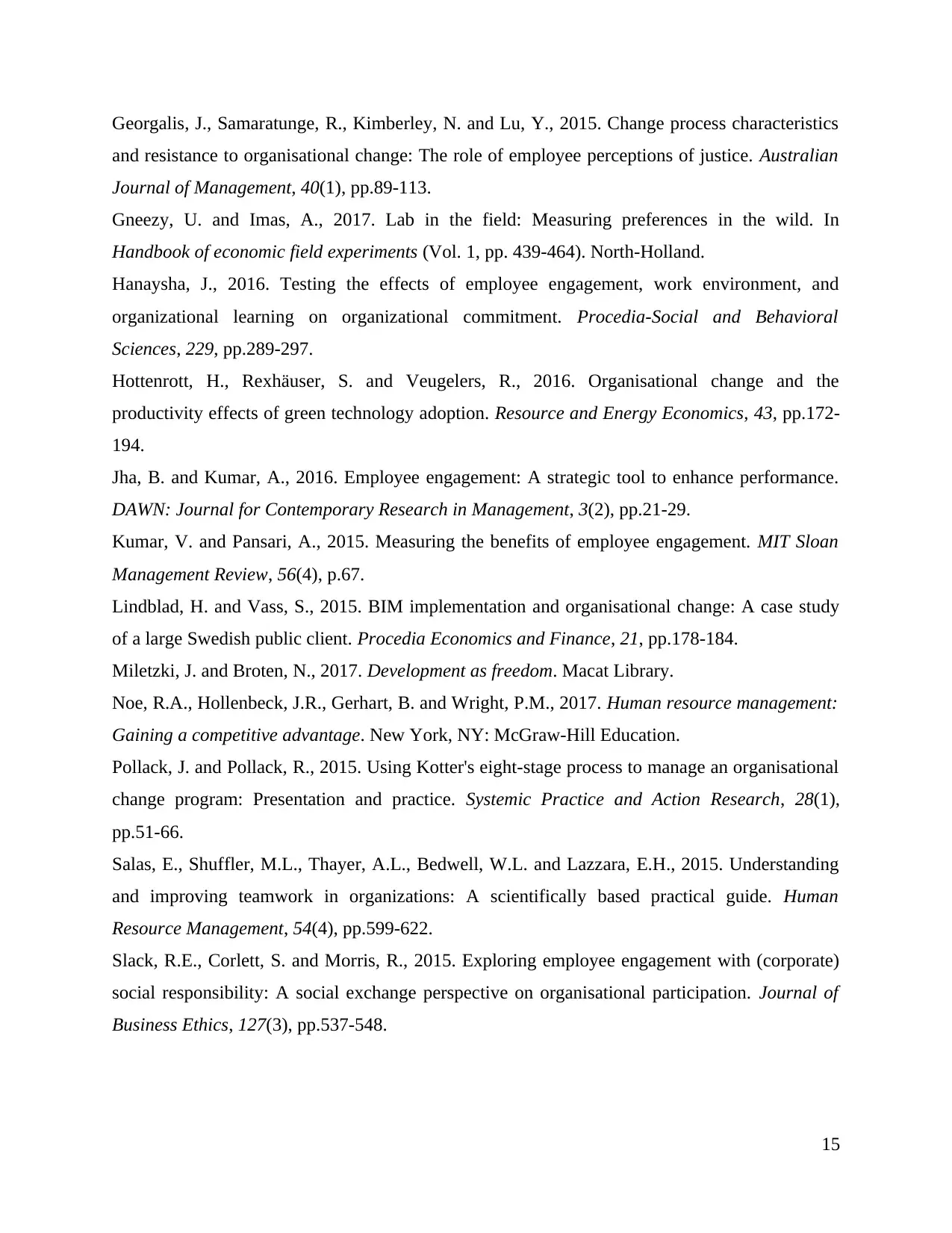
Georgalis, J., Samaratunge, R., Kimberley, N. and Lu, Y., 2015. Change process characteristics
and resistance to organisational change: The role of employee perceptions of justice. Australian
Journal of Management, 40(1), pp.89-113.
Gneezy, U. and Imas, A., 2017. Lab in the field: Measuring preferences in the wild. In
Handbook of economic field experiments (Vol. 1, pp. 439-464). North-Holland.
Hanaysha, J., 2016. Testing the effects of employee engagement, work environment, and
organizational learning on organizational commitment. Procedia-Social and Behavioral
Sciences, 229, pp.289-297.
Hottenrott, H., Rexhäuser, S. and Veugelers, R., 2016. Organisational change and the
productivity effects of green technology adoption. Resource and Energy Economics, 43, pp.172-
194.
Jha, B. and Kumar, A., 2016. Employee engagement: A strategic tool to enhance performance.
DAWN: Journal for Contemporary Research in Management, 3(2), pp.21-29.
Kumar, V. and Pansari, A., 2015. Measuring the benefits of employee engagement. MIT Sloan
Management Review, 56(4), p.67.
Lindblad, H. and Vass, S., 2015. BIM implementation and organisational change: A case study
of a large Swedish public client. Procedia Economics and Finance, 21, pp.178-184.
Miletzki, J. and Broten, N., 2017. Development as freedom. Macat Library.
Noe, R.A., Hollenbeck, J.R., Gerhart, B. and Wright, P.M., 2017. Human resource management:
Gaining a competitive advantage. New York, NY: McGraw-Hill Education.
Pollack, J. and Pollack, R., 2015. Using Kotter's eight-stage process to manage an organisational
change program: Presentation and practice. Systemic Practice and Action Research, 28(1),
pp.51-66.
Salas, E., Shuffler, M.L., Thayer, A.L., Bedwell, W.L. and Lazzara, E.H., 2015. Understanding
and improving teamwork in organizations: A scientifically based practical guide. Human
Resource Management, 54(4), pp.599-622.
Slack, R.E., Corlett, S. and Morris, R., 2015. Exploring employee engagement with (corporate)
social responsibility: A social exchange perspective on organisational participation. Journal of
Business Ethics, 127(3), pp.537-548.
15
and resistance to organisational change: The role of employee perceptions of justice. Australian
Journal of Management, 40(1), pp.89-113.
Gneezy, U. and Imas, A., 2017. Lab in the field: Measuring preferences in the wild. In
Handbook of economic field experiments (Vol. 1, pp. 439-464). North-Holland.
Hanaysha, J., 2016. Testing the effects of employee engagement, work environment, and
organizational learning on organizational commitment. Procedia-Social and Behavioral
Sciences, 229, pp.289-297.
Hottenrott, H., Rexhäuser, S. and Veugelers, R., 2016. Organisational change and the
productivity effects of green technology adoption. Resource and Energy Economics, 43, pp.172-
194.
Jha, B. and Kumar, A., 2016. Employee engagement: A strategic tool to enhance performance.
DAWN: Journal for Contemporary Research in Management, 3(2), pp.21-29.
Kumar, V. and Pansari, A., 2015. Measuring the benefits of employee engagement. MIT Sloan
Management Review, 56(4), p.67.
Lindblad, H. and Vass, S., 2015. BIM implementation and organisational change: A case study
of a large Swedish public client. Procedia Economics and Finance, 21, pp.178-184.
Miletzki, J. and Broten, N., 2017. Development as freedom. Macat Library.
Noe, R.A., Hollenbeck, J.R., Gerhart, B. and Wright, P.M., 2017. Human resource management:
Gaining a competitive advantage. New York, NY: McGraw-Hill Education.
Pollack, J. and Pollack, R., 2015. Using Kotter's eight-stage process to manage an organisational
change program: Presentation and practice. Systemic Practice and Action Research, 28(1),
pp.51-66.
Salas, E., Shuffler, M.L., Thayer, A.L., Bedwell, W.L. and Lazzara, E.H., 2015. Understanding
and improving teamwork in organizations: A scientifically based practical guide. Human
Resource Management, 54(4), pp.599-622.
Slack, R.E., Corlett, S. and Morris, R., 2015. Exploring employee engagement with (corporate)
social responsibility: A social exchange perspective on organisational participation. Journal of
Business Ethics, 127(3), pp.537-548.
15
You're viewing a preview
Unlock full access by subscribing today!
1 out of 15
Related Documents
Your All-in-One AI-Powered Toolkit for Academic Success.
+13062052269
info@desklib.com
Available 24*7 on WhatsApp / Email
![[object Object]](/_next/static/media/star-bottom.7253800d.svg)
Unlock your academic potential
© 2024 | Zucol Services PVT LTD | All rights reserved.




